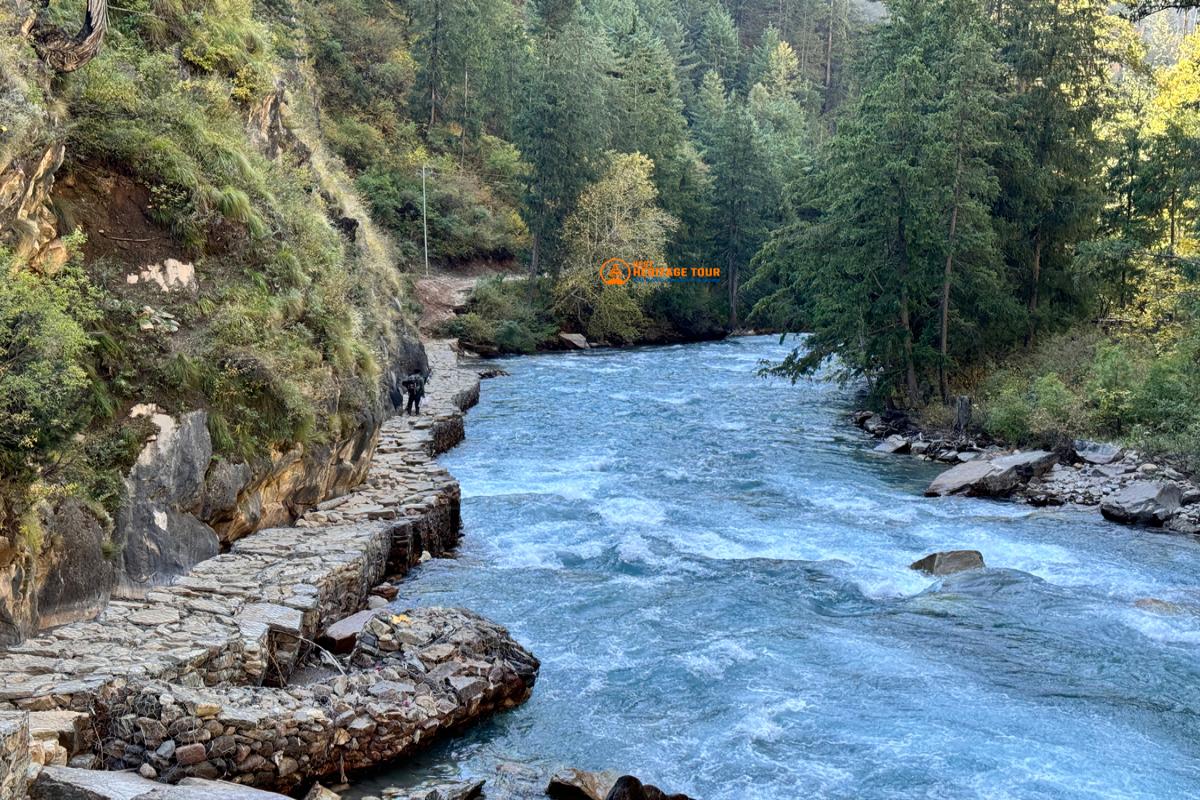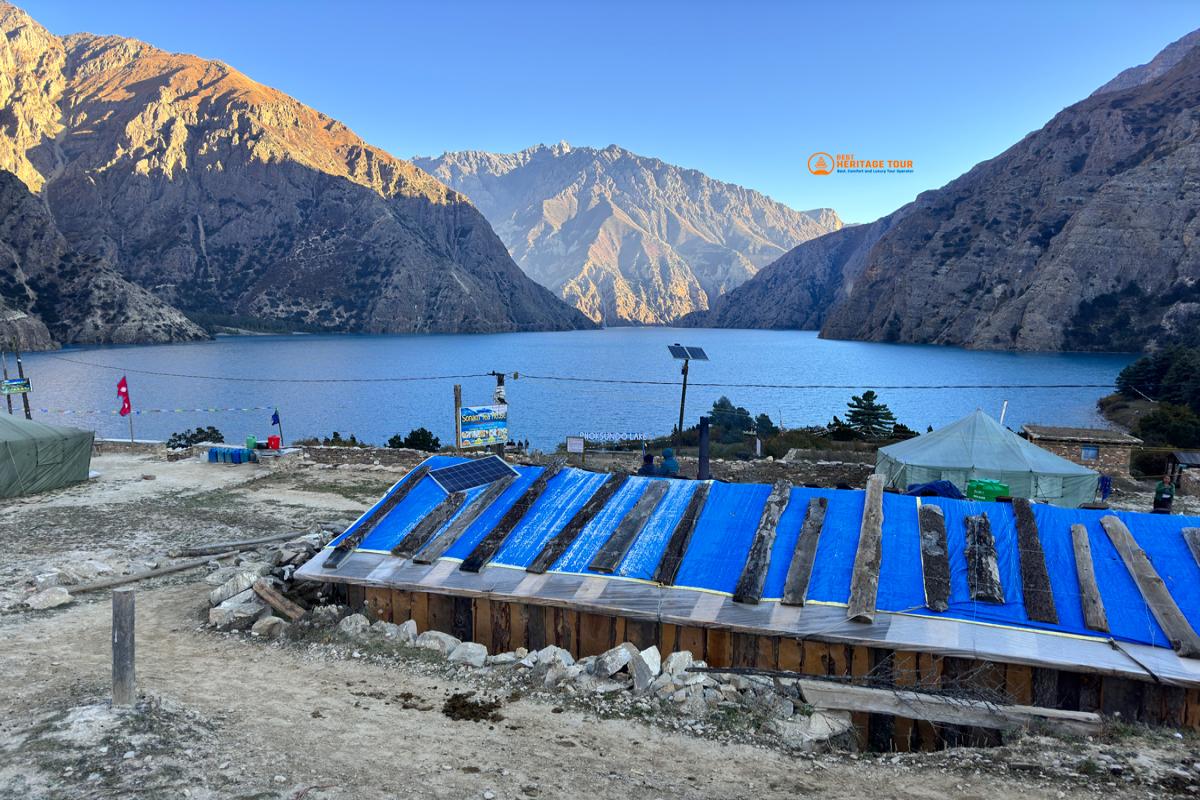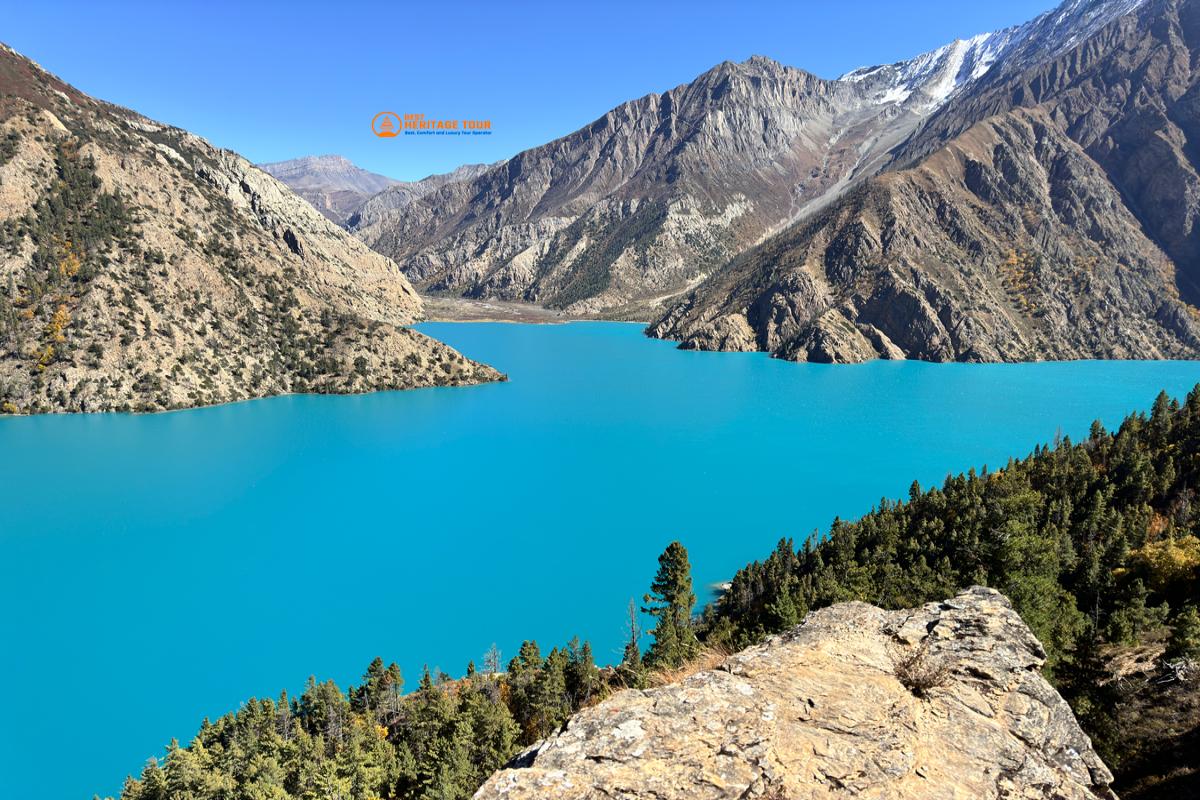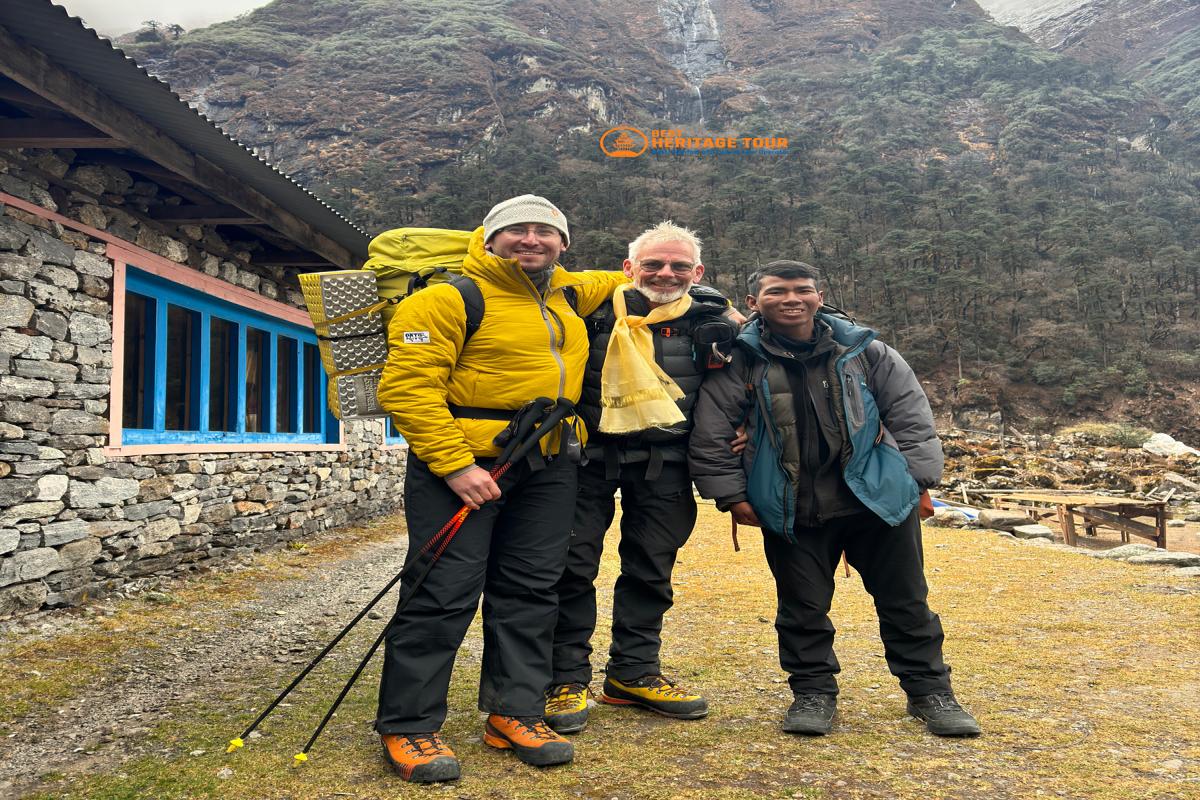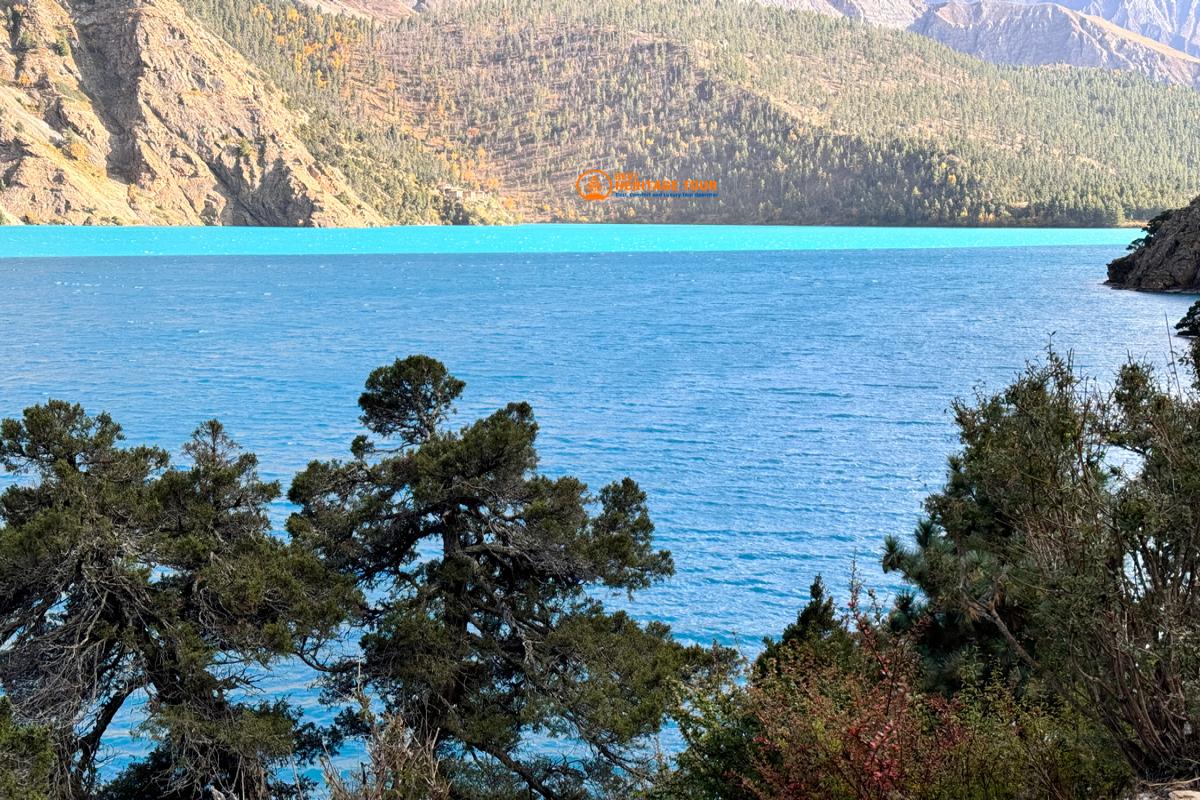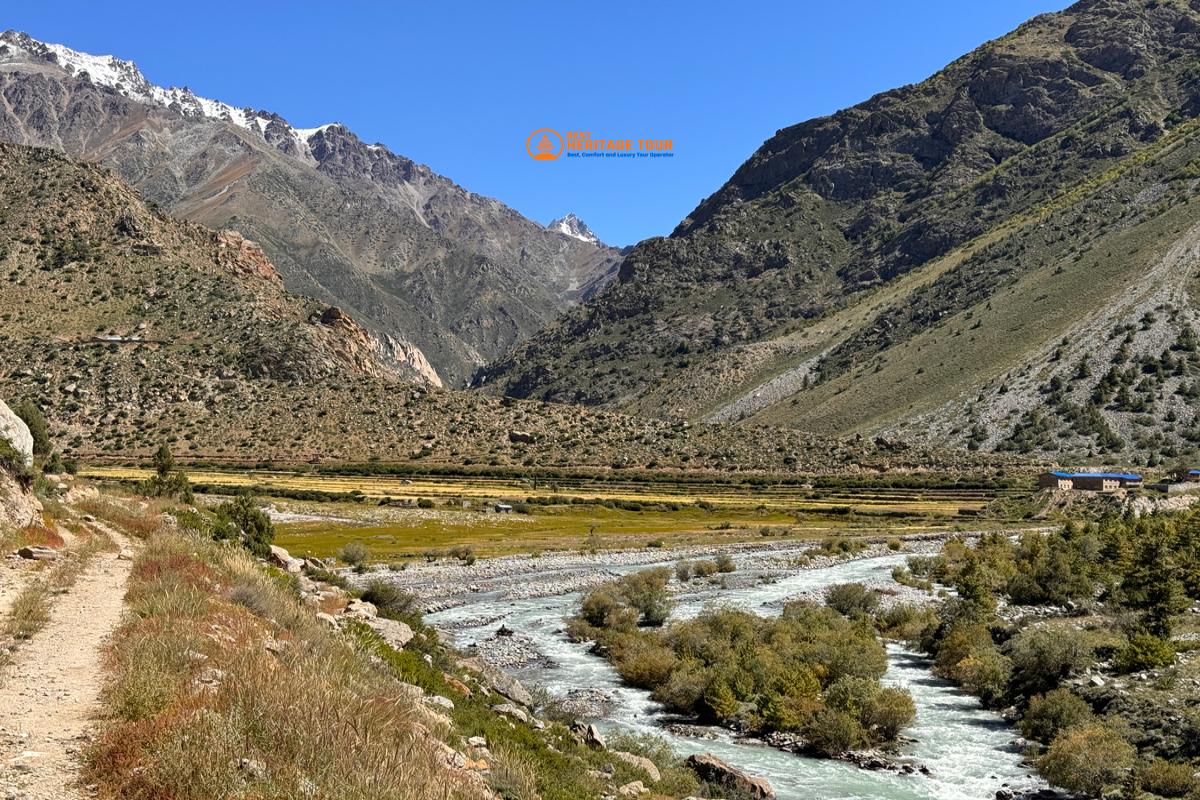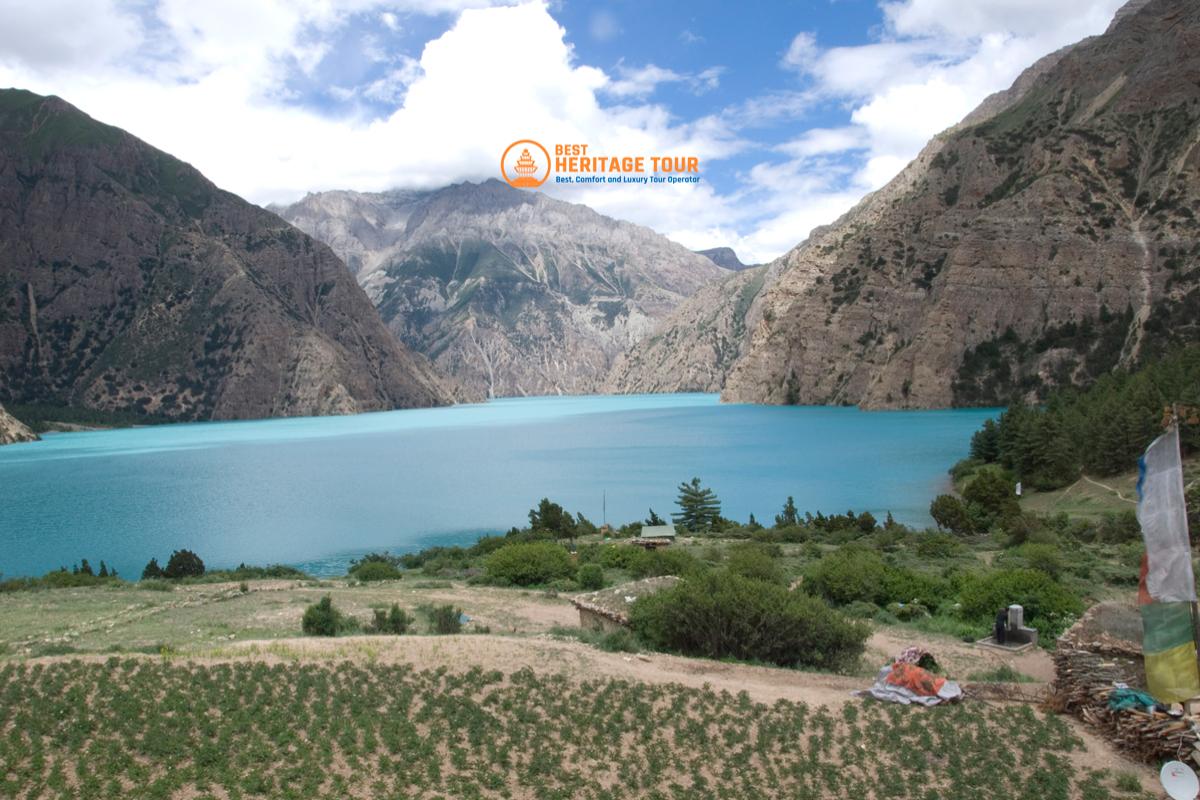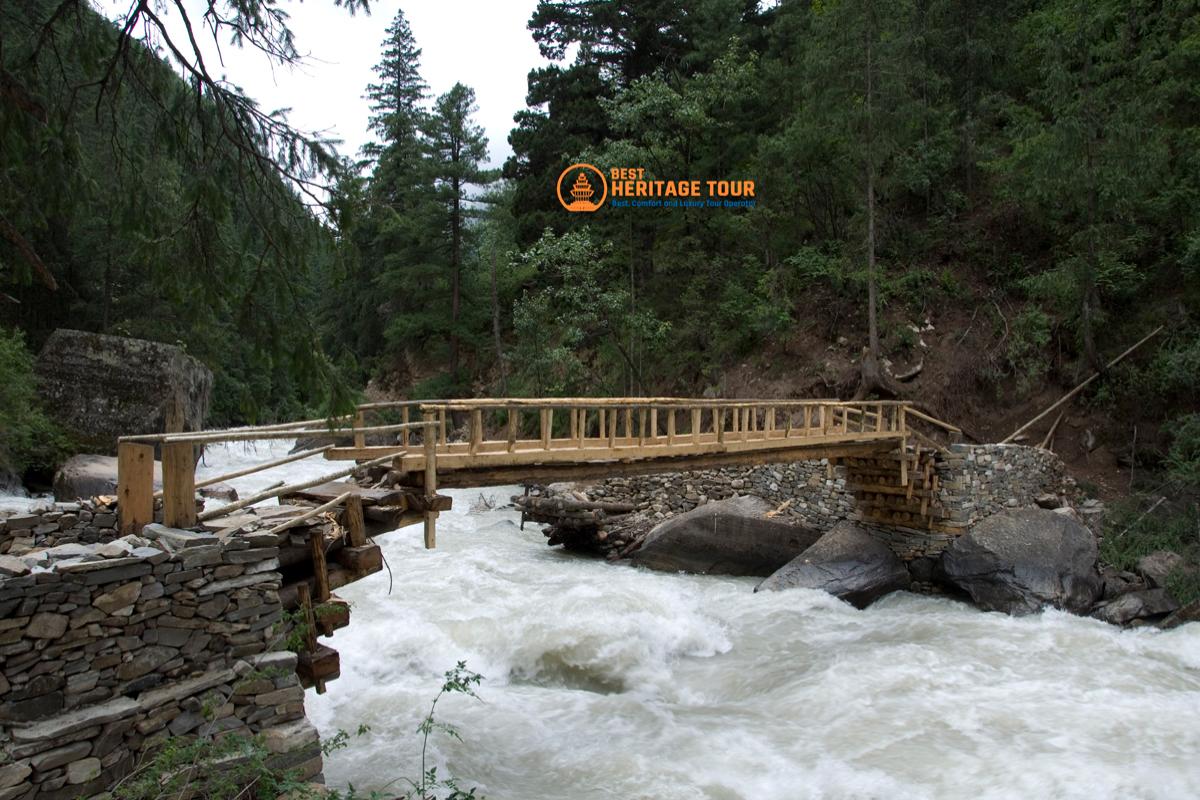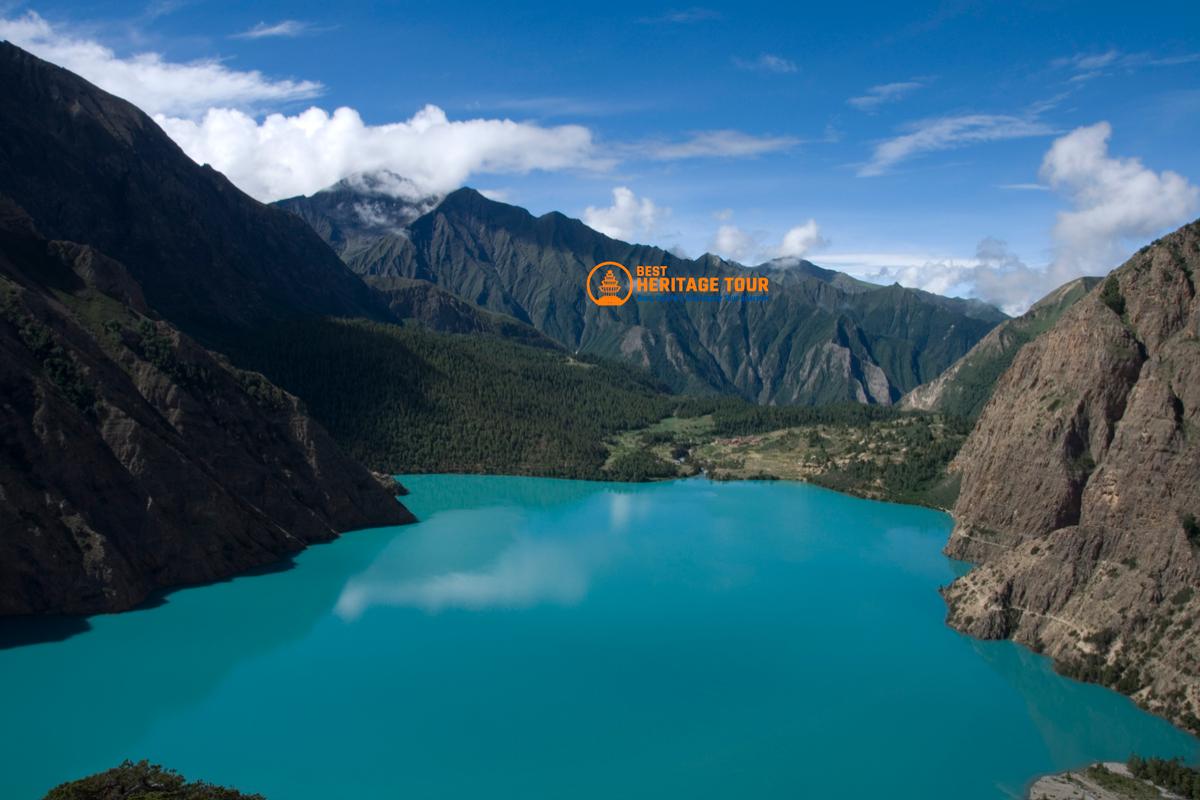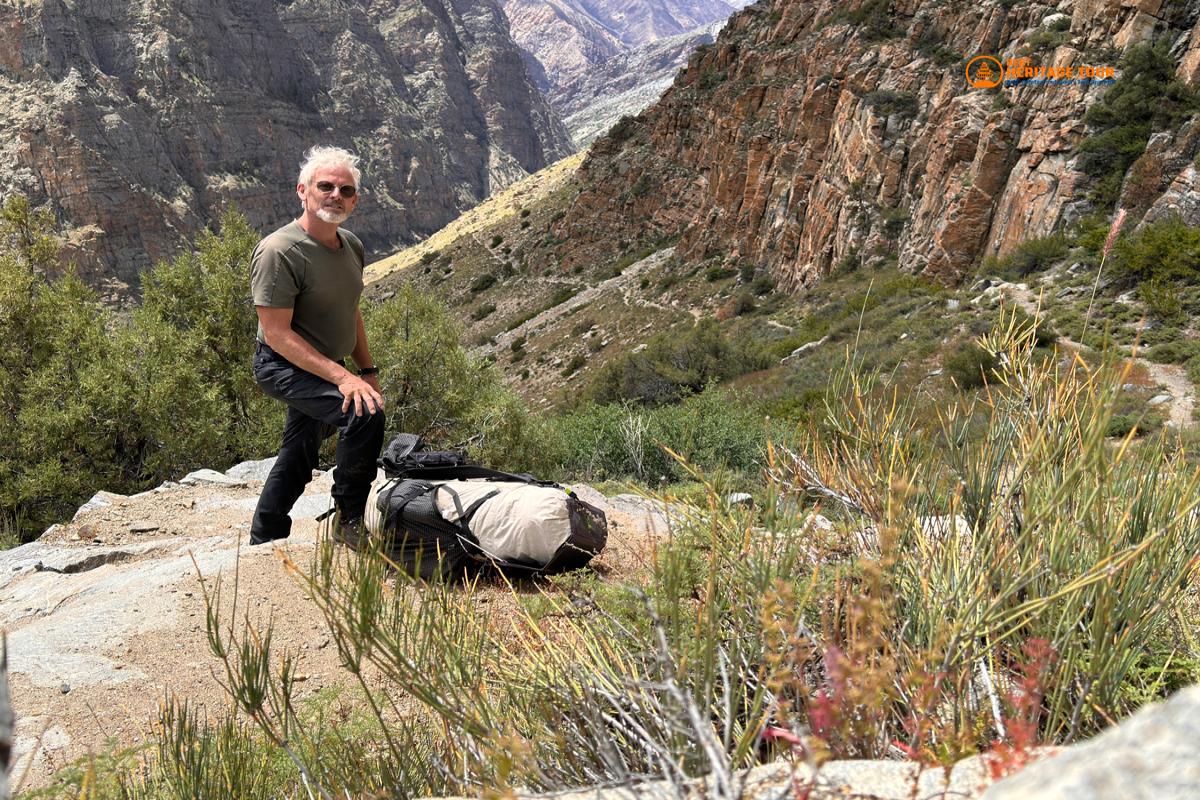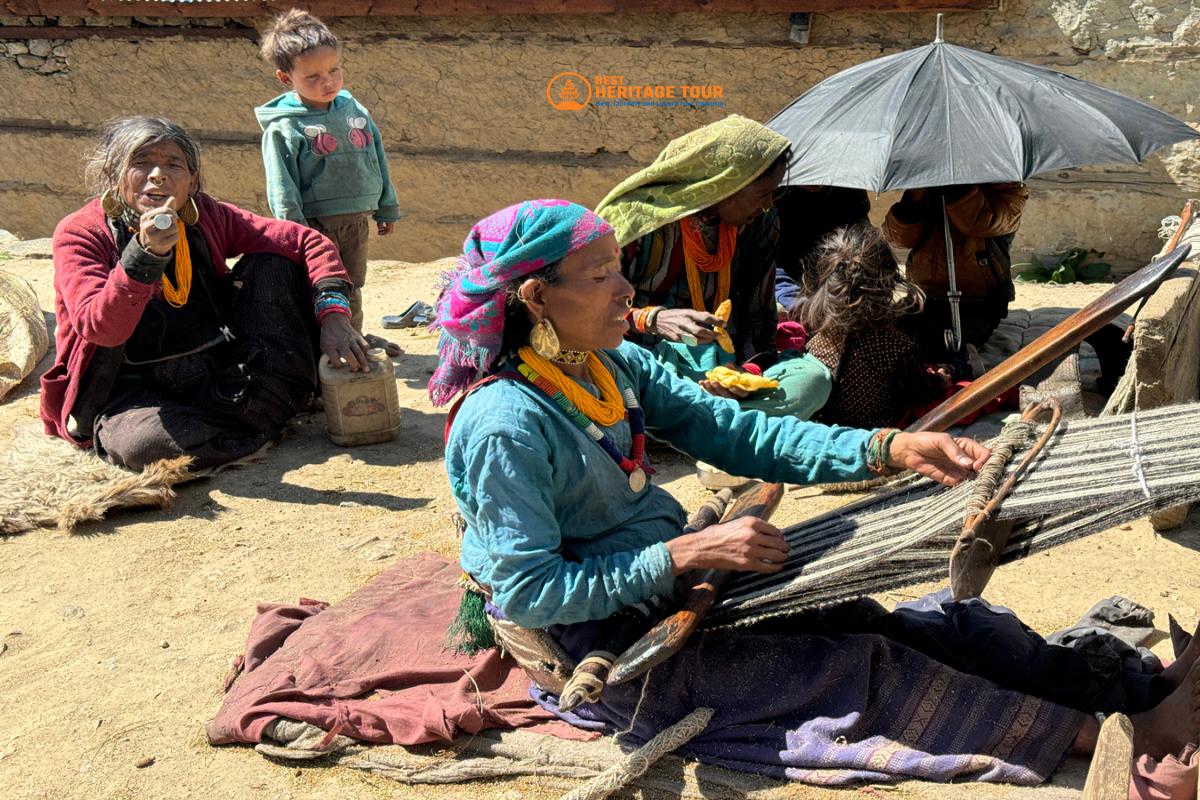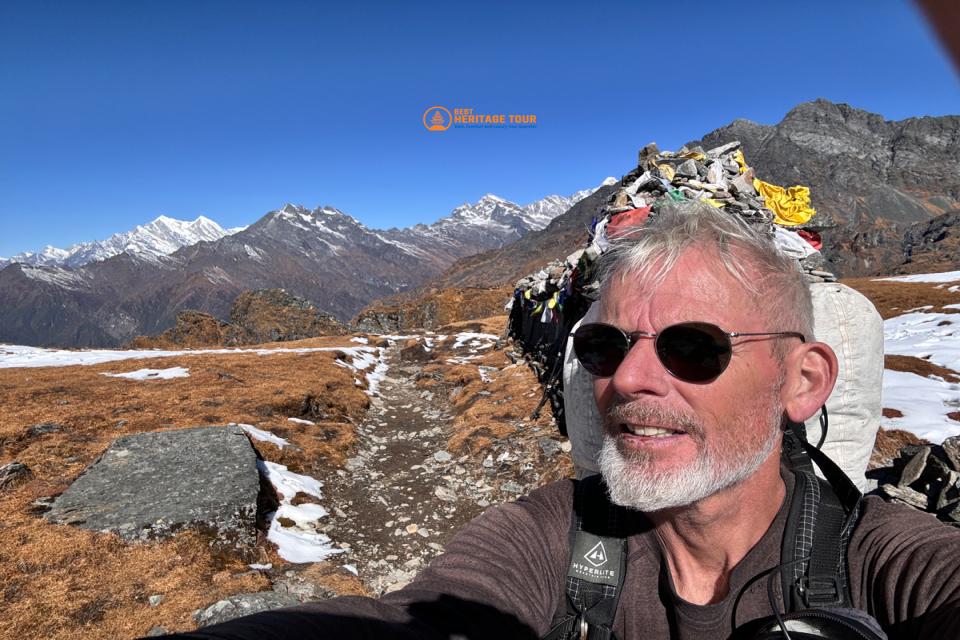Lower Dolpo Trek - 18 Days
Insight on Lower Dolpo Trek
The Lower Dolpo Trek offers an exciting journey through rugged landscapes, remote villages, and Tibetan culture. Trekking through isolated valleys, lush forests, and arid mountain terrain, adventurers will explore ancient monasteries and encounter unique wildlife. This trek provides a perfect blend of cultural immersion and natural beauty, with dramatic Himalayan views, serene lakes, and vibrant local life. It’s ideal for those seeking an off-the-beaten-path adventure that combines both physical challenge and spiritual discovery in one of Nepal’s least-explored regions.
Trip at a Glance
Key Highlights
- Trek through the pristine Shey Phoksundo National Park, home to wildlife like snow leopards, blue sheep, and Himalayan black bears.
- Explore remote villages with historic monasteries, stupas, and the 500-year-old Shey Gompa, experiencing local culture and traditions.
- Enjoy stunning landscapes, including high mountain passes, alpine meadows, rhododendron forests, and deep valleys.
- Visit Phoksundo Lake, with its turquoise waters surrounded by towering peaks, and see waterfalls like Suli Gandaki.
- Experience off-the-beaten-path adventure in one of Nepal’s most remote and unspoiled regions, offering solitude and authentic Himalayan trekking.
- Interact with local communities, learn about their lifestyle, taste traditional meals, and explore village markets.
Benefits of Booking the Lower Dolpo Trek with the Best Heritage Tour
- Complimentary airport transfer to & from hotel
- Online trip briefing after booking confirmation
- Easy booking and reservation system
- Multi-channel communication options available (email, WhatsApp, Facebook, WeChat, Viber, Skype, Zoom).
- 24/7 phone contact: +977-9851149197/+977-9810043046.
- Simple payment system.
- Medical kit including oximeter to monitor blood oxygen saturation at high altitude
- A sleeping bag and trekking poles will be provided if you do not have
- Free excess baggage check at Best Heritage Tours Store during the trek
Trip Overview
Lower Dolpo Trek on the western slopes of Nepal offers a fantastic trekking experience. Away from the hustle and bustle of the city, the Lower Dolpo region is considered one of the hidden gems of Nepal. Lower Dolpo Trek takes you on a remote trekking adventure and takes you to the tranquil Shey Phoksundo Lake, 3611 meters above sea level - one of the most beautiful lakes in Nepal. This lake lies on the border of Shey Phoksundo National Park, the largest national park in Nepal which is surrounded by high hills, with Mt. Kanjiroba in the distance.
Tibetan traditions and culture have had a major influence throughout the Lower Dolpo region. On the Lower Dolpo trek, you can encounter the pre-Buddhist Bon Po and Chaiba civilizations. Every year, hundreds of pilgrims come from all over the world to take part in the numerous festivals and celebrations held near the lake. You will encounter a wide variety of cultures, beliefs, and worldviews. The Annapurna range (8,091m), Dhaulagiri (8,167m), Api (7,132m), Nilgiri, Kagmara Ri (5,115m), and other nearby snow-covered peaks can be explored on the Lower Dolpo trek. Lower Dolpo trekking offers breathtaking views of snow-capped peaks as well as dry alpine landscapes.
The Lower Dolpo trek has been accessible to trekkers since 1991 and is considered one of the toughest treks in Nepal. Lower Dolpo is located on the northern side of the Himalayan range, just behind the Dhaulagiri peak. The ideal times for trekking in the Lower Dolpo are from early August to late October and from early March to early May. The landscape is very clear. Wildflowers are blooming everywhere, and you can feel the fresh air of the Himalayas. Lower Dolpo is the region with the least rainfall in Nepal and you can also trek during the monsoon season.
Lower Dolpo trekking is a challenging trek in western Nepal. You will walk off the beaten path along the way. A typical day involves 6-7 hours of hiking and crossing two mountain passes, which requires good physical endurance and overall good health. To embark on the Lower Dolpo trekking, you do not necessarily need to have prior trekking experience unless you are determined to complete the adventure. Today, the Lower Dolpo trekking route is very famous due to its natural manifestations such as high passes, rare flora and fauna, breathtaking landscapes, lakes, secluded Buddhist monasteries, and traditional Tibetan culture. The Lower Dolpo trekking route runs from 1650 meters to 5136 meters above sea level.
The 18-day Lower Dolpo trekking journey starts with a scenic flight from Kathmandu to Nepalgunj and Juphal. Starting the trek from Juphal, you will trek across terraced fields and small valleys to Dunai, enjoying the magnificent views of Mt. Dhaulagiri (8167m) and Mt. Annapurna (8091m). The Lower Dolpo trek takes you through Tarakot, Laini, Nawarpani, and several other beautiful villages before heading towards Juphal and proceeding to Dho Tarap village. You will take a day off to acclimatize at Dho Tarap and explore the local community. The Lower Dolpo trekking trail further crosses the challenging Numa La (5190m) and Baga La (5070m) passes before reaching the beautiful settlement of Ringmo. The next day, we will ascend to Phoksundo Lake, the most fascinating destination of the Lower Dolpo trek. After a day there, we will proceed to Shanta village. The Lower Dolpo trekking itinerary will return to Juphal and board a flight to Nepalgunj and then to Kathmandu.
We at Best Heritage Tours are happy to present you with our well planned and detailed Lower Dolpo trekking itinerary that will provide you with a once-in-a-lifetime experience. Bookings are now open for 2025 and 2026. We are ready to customize this package to suit your needs depending on your time, budget, and endurance. If you have any further queries regarding the price of Lower Dolpo trekking packages, feel free to Contact us.
What can I expect from Lower Dolpo trekking?
Lower Dolpo trekking offers a unique and secluded experience through the remote and less visited areas of the Dolpo region of Nepal. Here's what you can expect:
- This trek takes you through high passes, pristine valleys, and remote mountain villages surrounded by high mountains.
- This trek gives you a chance to see rare species of animals like blue sheep, Himalayan tahr, and snow leopards.
- Connect with the indigenous Dolpo people, known as the Dolpo-pas, who have a vibrant and distinct culture that includes their language, beliefs, and lifestyle.
- This trek is considered challenging due to the altitude, rugged terrain, and unpredictable weather conditions.
- Lower Dolpo is home to several ancient Buddhist monasteries, including Shey Gompa, one of the largest and most important monasteries in the region.
- This trek also provides an opportunity for meditation and spiritual reflection in the peaceful and tranquil environment of Dolpo.
Overall, trekking the Lower Dolpo is an adventure for anyone seeking a remote, challenging, and culturally enriching experience in the mountains of Nepal.
Is Lower Dolpo Trekking Suitable for You?
Lower Dolpo Trekking is challenging and suitable for those who are physically fit and adventurous. To decide if trekking is right for you, you should consider the following factors:
- Trekking involves long periods of walk at high altitudes, so you should be in good physical condition and have experience of long-distance hiking.
- Trekking is physically and mentally demanding and you should be prepared for the long days of hiking and isolation that comes with trekking in remote areas.
- Trekking takes you to high altitudes, so you should be prepared for symptoms of altitude sickness such as headaches, nausea, and shortness of breath.
- The Lower Dolpo trek is in a secluded area, so be ready for limited facilities and services during the journey.
- The Lower Dolpo trek can be quite costly, so it's important to factor in expenses for permits, guides, and gear.
- The trek takes place in the rainy season, so you should be prepared for rain, cold, and wind.
- If you have little experience in trekking or high-altitude hiking, you should consider a shorter or less strenuous trek before the Lower Dolpo trek.
- Make sure you have adequate travel insurance to cover emergency evacuation, medical expenses, and other potential risks.
If you feel fit and ready for the demands of hiking, exploring the Lower Dolpo can be a fulfilling adventure. However, if you have any health issues or concerns, we recommend consulting a doctor before embarking on the hike.
Itinerary
As you land at Tribhuvan International Airport, you will be met by a representative from Best Heritage Tours. He will then drive you to your hotel and assist you with check-in. After rest, please drop by our office for information about the Lower Drop trekking itinerary. As a token of our gratitude and welcome to Nepal, the company will prepare a welcome dinner for you.
Today you will take a tour of Kathmandu with your tour guide. After breakfast, start your tour with a visit to the first tourist spot, Pashupatinath Temple. From here you will proceed to Boudhanath Stupa. The next destinations on your journey will be Swayambhunath and Kathmandu Durbar Square. All these sites are UNESCO World Heritage Sites showcasing the rich cultural heritage of Nepal. Your Lower Dolpo trekking guide will pick you up in the late afternoon.
After breakfast, board a domestic flight from Kathmandu to Nepalgunj with your guide and other crew members to begin your 18-day Lower Dolpo trekking trip. After a 1-hour scenic flight, you will reach Nepalgunj, the gateway to Simikot. In the afternoon, explore the lively market, mini zoo, and nearby towns.
Today begins the main adventure of the Lower Dolpo trek. After a delicious breakfast in Nepalgunj, fly from Nepalgunj to Juphal. The flight is short and scenic. After reaching Juphal, start your trek towards Dunai. Along the entire route, you will enjoy breathtaking views of Mt. Dhaulagiri (8,167m) and Mt. Annapurna (8,091m). You can hike through terraced fields to reach the Bheri River. From here, the route continues through a small valley to Dunai, the administrative center of the Dolpo region.
Start your trek from the south bank of the Bheri River, then climb upstream on an easy route. Along the way, you will pass through several steep gorges, exciting suspension bridges, and beautiful secluded villages. Walk along the Lower Dolpo Trekking Trail to Tarakot, a small hilltop community south of the Bheri River, where you will spend the night in a tea house.
Today, the route for the Lower Dolpo trek follows the Tarap Chu River. To reach Sandur Gompa, which is located between the Barbung Khola and Tarap Chu Rivers, one has to cross this river twice. Afterwards, continue to wander through terraced communities and farms. To reach Laini, you will have to climb up and down several times.
Begin your trek after breakfast. It's a challenging hike over the Tarap River. As the valley continues, it narrows and turns into a canyon, so you can easily jump from one side to the other. After a difficult climb and descent, you finally reach Chyugur Khola. From here it's a short walk to Nawarpani where you will spend the night in a tea house.
After leaving Nawarpani you will gradually climb to Kamattarka where the Tarap Chu and Lang Khola rivers join. Leaving the tree line behind you, you will cross a small gorge and enter an arid inland Himalayan valley where you will be greeted by magnificent juniper and wild rose shrubs. From here you will follow the Lower Dolpo Trekking trail to the hamlet of Dho Tarap surrounded by curved stone walls where you can practice the unique Bon Po and Chaiba religions.
According to the Lower Dolpo trekking itinerary, this is an acclimatization and recovery day at Dho Tarap village. This rest day will help you get used to the environment and allow you to explore the community and its surroundings. You will have the opportunity to talk to the residents and get to know their way of life, culture, and traditions. The religions practiced here are Chaiba and Bon Po. You will be able to taste their products and admire their beautiful costumes.
Today's Lower Dolpo Trekking Trail takes you to the upper Tarap Valley where you can see green grasslands on both sides of the beautiful river. You can hike along the Tarap Chu River to Tokyo. Here you can explore the Chiba Sect Monastery. Then hike through difficult terrain to reach Numa La Base Camp where you will spend the night.
This day will be the longest and most difficult day of the Lower Dolpo Trekking itinerary. After a delicious breakfast, we head uphill towards Numa La Pass. From the top of the pass (8,167m) we have a breathtaking view of the arid Dolpo mountain ranges, rising to Dhaulagiri. We spend some time there before heading to Pelung Tang, where we spend the night in a tented camp.
Today you will cross another pass. To get to Baga La Pass you have to walk a difficult path. Once again, the view from the top of the desert pass, with Mt. Kanjirowa in the distance and the snow-capped mountains is breathtaking. After a while, the Lower Dolpo trekking route reaches Dajok Thang where you will spend the night. You will spend the night in a tea house.
The Lower Dolpo trekking trail passes mostly through the high mountain greenery and lush pine trees. You will arrive at Ringmo village, a Tibetan settlement located in the Dolpo region, following a trek that is relatively less challenging than the previous day's trek.
Wake up early and enjoy a delicious breakfast. Then the Lower Dolpo trekking trail leads to Phoksundo Lake at an altitude of 3,611 meters. This lake is the most attractive place in Dolpo. During the trip, you can visit a yak caravan and a local monastery. Upon reaching Phoksundo Lake, you will be greeted by a breathtaking setting. Today you will spend the night near the lake. You will spend the night in a tea house.
After breakfast at Phoksundo Lake, start your descent to Shyanta village. You will reach Chepka. From here the Lower Dolpo trekking trail continues, passing through various settlements along the huge overhanging cliffs. Along the way, you will pass therapeutic minerals that are believed to cure virtually everything in the region. Continue climbing until you reach Shanta village where you will spend the night in a tea house.
Today you will return to Juphal via Sulighat. On the way, you will pass many birch trees and enjoy breathtaking mountain views. Upon arrival in Juphal, rest and spend the evening exploring the market. You will spend the night at a tea house in Juphal.
Today they will travel consecutively, first to Nepalgunj and then to Kathmandu. The Lower Dolpo trekking schedule will finish when they arrive in Kathmandu, where they will check into a hotel and have a relaxing day. This evening, they are set to attend the farewell party organized by the company. Also, prepare for your return trip tomorrow.
Check out of the hotel after breakfast. A representative from Best Heritage Tours will accompany you to the airport to board your flight back home.
What is included?
- Air tickets from Kathmandu to Nepalgunj and then to Juphal or vice versa (including departure tax)
- All land travel will be by private vehicle, which includes transfers to and from the airport
- Accommodation in Kathmandu with breakfast
- Kathmandu Valley sightseeing tour (including guide, entrance fees, and private vehicle)
- All meals (breakfast, lunch, dinner, tea, and coffee)
- Accommodation in Teahouses or tented camps for 2 people during the trek
- An experienced English speaking trekking guide and porters (1 porters for 2 trekkers with maximum baggage limit of 25 kg)
- All expences of Guide and Porters such as salary, meals, accommodation, travel insurances etc
- Trekking equipment (tent for 2 people, dining tent, kitchen tent, table with chairs, cooking utensils, and other equipment required during the trek)
- One-night stay in Nepalgunj with breakfast
- Comprehensive first aid bag & Safe boiled drinking water is provided during the trek
- All necessary permits and documents, including the special permit for upper Dolpo
- Farewell Dinner in Kathmandu
What is not included?
- International Airfare
- Visa fee to be paid at Airport
- Additional night accommodation in Kathmandu due to early arrival or late departure, or early return from the trek
- Personal expenses (shopping, snacks, boiled bottled water, hot (tea / coffee) and cold drinks, hot shower, alcohol, Wi-Fi, telephone call, battery recharge fee, extra porters, etc
- Personal clothing and gear
- Travel insurance covering emergency high-altitude rescue and evacuation (mandatory)
- Tips for guides and porters (recommended)
- Additional costs resulting from factors beyond our control, such as landslides, weather conditions, itinerary adjustments due to safety concerns, illness, changes in government policies, strikes, etc
- Anything that is not mentioned in Itinerary & Included section
- All government taxes 13%, SSF, and 10% service charges
Route Map
Equipment
Clothing
-
Base Layers: Moisture-wicking shirts and thermal leggings
-
Insulating Layer: Fleece or down jacket for warmth at high altitudes
-
Outer Layer: Waterproof and windproof jacket and pants
-
Trekking Pants & Shirts: Lightweight, quick-drying, and comfortable
-
Hat & Gloves: Warm hat, sunhat, and insulated gloves
-
Socks: Trekking socks and thermal socks for high-altitude areas
Footwear
-
Trekking Boots: Waterproof, sturdy, and broken-in boots with good ankle support
-
Camp Shoes / Sandals: Comfortable footwear for evenings at lodges or tea houses
Essential Gear
-
Backpack: 40-60L daypack with rain cover
-
Sleeping Bag: Suitable for sub-zero temperatures (down to -15°C)
-
Trekking Poles: Adjustable poles for balance on rugged terrain
-
Water Bottle / Hydration System: Minimum 2L capacity
-
Headlamp / Flashlight: With extra batteries
-
Sunglasses & Sunscreen: High-altitude UV protection
-
Toiletries & Personal Hygiene: Quick-dry towel, biodegradable soap, tissue paper
-
First Aid Kit: Include personal medications, blister treatment, and altitude sickness medication
Optional / Extra Items
-
Camera / Binoculars: For capturing landscapes and wildlife
-
Power Bank / Solar Charger: To keep electronics charged
-
Snacks / Energy Bars: For energy during long trekking days
-
Gaiters: For snow or muddy trails
-
Lightweight Trekking Shirt or Buff: For sun protection or dust
Trip Info
Preparing for the Lower Dolpo Trekking
Preparation is essential to making the Lower Dolpo Trekking a successful and enjoyable experience. You can follow these steps to get ready:
-
Physical Training: Start a regular workout plan with cardio and strength training a few months before your trek to improve your endurance and reduce the risk of injury.
-
Acclimatize to the altitude: If possible, spend time at high altitude before the trek to acclimatize to the thin air and reduce the risk of altitude sickness.
-
Stock up on gear and supplies: Invest in quality gear and essentials, such as quality trekking boots, warm clothing, and a reliable backpack. Get any gear you need by renting or purchasing it.
-
Get necessary permits: Obtain the necessary permits and trekking visas to enter the restricted areas of the Dolpo region.
-
Trekking Knowledge: Get to know the trail, the cultural and natural sights you will encounter, and the potential challenges and dangers of the trek .
-
Hire a guide: If you don't have experience with high-altitude trekking, consider hiring a local guide who can provide support, information, and help along the way.
-
Pack properly: Pack wisely with a focus on light, energy-rich foods, and snacks, a first aid kit, water purification tablets, etc.
Best Time, Season, and Month to Trek the Lower Dolpo
The best time to trek the Lower Dolpo depends on your weather and crowd preferences. The trekking season in the Dolpo region lasts from late September to November and March to May. Here is an overview of each season:
-
September to November: Autumn is the main trekking season in Dolpo, and you can expect good weather and clear skies. However, it may get crowded with other climbers.
-
March to May: Spring is also a great time for trekking as temperatures are warm and the rhododendrons are in bloom. Treks may be less crowded than in peak season.
-
Winter: Winters in Dolpo can be very cold, with heavy snow and freezing temperatures. Trekking during this time is not recommended.
Overall, the best time to trek in Dolpo depends on your preferences regarding weather and crowds. If you want good weather and clear skies, September to November is the best time. If you want to avoid crowds, consider trekking from March to May.
Meals or Food
Depending on the route and length of your Lower Dolpo trek, the food and meals available may vary. We provide 16 breakfasts, 13 lunches, and 14 dinners during your trekking trip. What awaits you:
-
Teahouses: Along the more popular routes, there are teahouses serving meals and snacks such as dal bhat (lentils and rice), momo (dumplings), and soups.
-
Camping: If you go on a camping trek, you will need to bring your own food such as instant noodles, oatmeal, and dried fruit. Usually, your guide will arrange for a chef to prepare your meals.
-
Snacks: Snacks such as energy bars, trail mix, and fruit can be purchased in the surrounding villages and tea houses along the route.
-
Special Dietary Requirements: If you have special dietary requirements, it is important to inform your guide in advance and discuss food options and available meals.
In the remote areas of Lower Dolpo, the food options available may be limited. It is therefore important to prepare basic camping dishes and bring extra snacks to supplement your meals. It is also important to note that hygiene practices when preparing and storing food may vary from situation to situation. Therefore, be sure to follow proper food safety practices to reduce the risk of foodborne illness.
Lower Dolpo Trek Accommodation Facility
Accommodation during the Lower Dolpo Trek will vary depending on the route and type of trek you choose. Here is what you can expect:
-
Teahouses: Along the more popular routes, you will find teahouses offering basic accommodation such as shared rooms with bunk beds, and shared bathrooms.
-
Camping: If you are going on a camping trek, you will need to bring your tent and camping gear. Your guide will arrange campsites for you along the way.
-
Private Accommodation: Private accommodation may be available in some remote villages, allowing you to experience the local culture and stay with a local family.
-
Lodges: In some areas, lodges are available that offer more comfortable and spacious accommodation, including private rooms with en-suite bathrooms.
The standard of accommodation in the Lower Dolpo is basic, and electricity and hot showers may not be available in some locations. It's essential to get ready for a more rugged trekking adventure and pack the right gear. Be sure to discuss your accommodation preferences with your guide in advance and be flexible and open-minded about available accommodation along the way.
Difficulty Level of the Lower Dolpo Trek
The Lower Dolpo Trek is considered a challenging trek and is rated as moderate to difficult, with some steep and rugged sections. Factors that determine the difficulty are:
-
Altitude: The trek passes through several high altitudes of over 5,000 meters, which can be physically demanding and increase the risk of altitude sickness.
-
Distance: The trek covers significant distances and each day's stage can last several hours. Be prepared for long treks with a heavy backpack.
-
Terrain: The trek covers many different types of terrain, including rocky paths, narrow tracks, steep climbs, and slopes. The paths can be slippery and difficult, especially when wet.
-
Remoteness: The Lower Dolpo trek is a remote trek with limited facilities and services along the route. You should be prepared for no amenities, and you will need to bring your food, water, and other necessities.
Requirement of Travel Insurance during Lower Dolpo Trek
Travel insurance is highly recommended for the Lower Dolpo River trek. The trek takes place in a remote and isolated area with limited access to medical facilities. Travel insurance provides valuable coverage in the event of an emergency, including:
-
Emergency Evacuation: In the event of a medical emergency or injury, your travel insurance may cover the cost of emergency evacuation to the nearest medical facility.
-
Medical Expenses: Travel insurance covers the cost of medical treatment, including hospitalization and medications.
-
Trip Interruption or Cancellation: If you need to cancel or interrupt your trek due to unforeseen circumstances, your travel insurance may cover the cost of trip cancellation or change.
-
Loss of personal belongings: Travel insurance covers the loss or theft of personal belongings, including trekking gear and equipment.
-
Adventure activities: Some travel insurance policies cover adventure activities such as trekking that are not covered by standard travel insurance.
It is important to carefully review your travel insurance policy to ensure that it provides adequate protection for your specific needs and the challenges of the Lower Dolpo trek. Remember to carry a copy of your travel insurance policy with you during your trek.
Altitude sickness during the Lower Dolpo trek and its treatment
Altitude sickness is a common problem faced by trekkers in high-altitude regions, and the Lower Dolpo trek is no exception. Altitude sickness occurs when you ascend too quickly, and your body is unable to adapt to the reduced oxygen levels at high altitudes. Here are some treatments to prevent or reduce the symptoms of altitude sickness:
-
Gradual Ascent: To reduce the risk of altitude sickness, it is important to follow a gradual ascent pattern and give your body time to acclimate to the high altitude.
-
Hydration: Staying hydrated is important to prevent altitude sickness. So, drink plenty of water and avoid alcohol.
-
Proper Nutrition: A high-energy diet rich in carbohydrates and protein will help prevent altitude sickness and maintain your energy levels.
-
Acclimatization: Spending extra time at a high altitude and taking rest days will help your body adapt to the high altitude.
-
Medications: You may be prescribed medications such as acetazolamide to prevent altitude sickness. Consult your doctor before taking any medications.
If you experience any symptoms of altitude sickness, it is important to descend to a lower elevation and seek medical attention if necessary. Altitude sickness can cause headaches, nausea, dizziness, and tiredness. It's crucial to recognize these signs and respond if they happen.
Lower Dolpo Trekking Guides and Safety
Trekking guides are a valuable aid during your trek in the Lower Dolpo region, helping you get oriented along the way, providing information on local culture and history, and dealing with any problems or emergencies that may arise. Benefits of having a trekking guide on your Lower Dolpo trek include:
-
A guide knows the best paths and can help you find your way through the tough and remote areas of the Lower Dolpo Trek.
-
A guide is trained in basic first aid and can help during emergencies like altitude sickness or injuries.
-
A guide understands the local culture and history, offering valuable insights into the unique region of Dolpo.
-
A guide can assist with trek logistics, including transportation, accommodation, and making sure you have all the necessary permits and visas.
-
If you don’t know the local language, a guide can help you talk to local people and enhance your trekking experience.
Choosing a reliable and experienced guide is important when trekking the Lower Dolpo. You can ask friends or travel agents for recommendations or look for guides who are certified by organizations like the Nepal Academy of Tourism and Hotel Management.
Visa for Nepal
All international travelers (except Indian citizens) require a Nepal tourist visa to join the Lower Dolpo Trek. Visas can be obtained on arrival at Tribhuvan International Airport in Kathmandu or at designated land border entry points.
The process is simple: fill out the application form, provide a passport-sized photo, and pay the visa fee for 15, 30, or 90 days, depending on your travel plans. Ensure your passport is valid for at least six months. For convenience, you can also apply online through the official Nepal Immigration website before arriving.
Booking & Payments
To confirm your Lower Dolpo Trek, a 10% deposit of the total price is required at the time of booking, with the remaining balance payable before the trek begins. Payments can be made via bank transfer, credit card, or cash, though credit card payments may include additional charges.
The cancellation policy depends on the notice period; full details are provided during the booking process in our Terms & Conditions. Group discounts and private departures can also be arranged to suit your preferences.
Last-Minute Booking
While early booking is recommended, Best Heritage Tour accommodates last-minute bookings for the Lower Dolpo Trek. For these, full payment (100% of the trip price) is required at least 24 hours before departure.
Please note that availability of permits, flights, and accommodations may be limited during peak season. For assistance, contact us at +977-9851149197 / +977-9810043046 or email info@bestheritagetour.com | bestheritagetour@gmail.com.
Trip Extension
If you wish to extend your adventure beyond the Lower Dolpo Trek, Best Heritage Tour offers several exciting options. You can explore nearby trekking routes, cultural tours around Nepal, visits to Lumbini, or relaxing stays in Pokhara.
Our team will help customize your itinerary to match your interests, schedule, and fitness level, ensuring a seamless and memorable extension to your Dolpo adventure.
Review
Great Himalayan trail with best heritage tour
Had great experience with best heritage tour to se faksundo and part of great Himalayan trail with well organized and best experience
View DetailUnforgettable Adventure in Lower Dolpo
My wife and I recently finished the Lower Dolpo Trek with the Best Heritage Tour, and it was one of the most memorable trips of our life. From the beginning, communication with the...
View DetailA True Off-the-Beaten-Path Adventure of Lower Dolpo Region
As an experienced trekker, I was looking for some off-the-beaten-path, and the lower Dolpo Trek gave beyond my expectations. The landscapes were wild and untouched, making me felt...
View DetailFAQ's
Yes, all our guides are fluent in English and many speak other languages. This facilitates clear communication and enhances your overall experience.
Most trekking guides in Nepal speak basic to advanced English, which is enough for general communication about trekking and safety precautions. Some speak more fluent English, which will improve your overall trekking experience.
Yes, most visitors need a tourist visa to enter Nepal. A visa can be obtained on arrival at Tribhuvan International Airport in Kathmandu or applied for in advance at a Nepalese embassy or consulate.
Yes, you will need two passport-sized photos for both the visa application and the trekking permits, so it's a good idea to bring extra copies just in case.
You'll need a valid passport (with at least six months validity), a passport-sized photo, and the visa fee (which varies depending on the duration of stay).
To obtain the RAP, you’ll need:
- A valid passport.
- A Nepal visa.
- Travel insurance.
- Two passport-sized photos.
- A letter from your trekking agency detailing your itinerary and the names of the guide and group.
Yes, it’s possible to extend your visa if you wish to stay longer in Nepal. Extensions can be processed at the Department of Immigration in Kathmandu or Pokhara, but you should apply before your current visa expires.
You can exchange US dollars or Euros for Nepalese rupees upon arrival, but we recommend carrying cash in the local currency for most transactions outside of major cities.
Hygiene standards may vary. Most teahouses strive for cleanliness, but it is wise to temper your expectations, especially in remote areas.
Yes, teahouses are generally safe and many hikers have had good experiences with them, but it's wise to use common sense, lock up your valuables, and choose a reputable establishment recommended by your guide.
To ensure you are comfortable while trekking, your backpack should ideally weigh 10-15% of your body weight, usually around 10-15 kg (22-33 lbs).
Physical preparation is essential to a successful trekking experience. Begin an exercise program 6-8 weeks before your hike that focuses on:
- Aerobic exercise: Activities such as running, cycling, and swimming to improve endurance.
- Strength training: Leg, core, and upper body exercises to increase strength.
- Practice hiking: Fill up your backpack and go on a short hike to simulate trekking conditions.
Hiring porters is not mandatory but highly recommended. Carriers allow you to carry heavy loads and make the hike more comfortable. This also supports the local economy and creates jobs in the area.
It is important to stay hydrated while climbing. Bring a reusable water bottle and use water purification tablets or a filter if necessary. Pack energy-rich snacks such as nuts, energy bars and dried fruit to maintain your energy levels throughout the day.
Before any hike, test your equipment on a training hike to make sure everything fits well and works properly. Ensure that you break in your trekking footwear to prevent blisters and discomfort.
Yes, we recommend that you have a small first aid kit with some basic items such as adhesive tape, disinfectant wipes, painkillers, altitude sickness medication, and personal medications.
Yes, you can rent trekking gear in Kathmandu and other major cities. However, we recommend that you check the quality and suitability of the equipment before renting.
Acclimatization helps your body adapt to high altitudes and reduces the risk of altitude sickness. Gradual ascents and rest days are essential to acclimatize effectively.
Pay attention to your body's signals, especially when fatigue sets in.
- Take a break: Take a break when necessary and find a comfortable place to sit and relax.
- Stay hydrated: Drink water regularly and eat snacks to replenish your energy.
- Inform your tour guide: Should you begin to feel unwell, it is important to communicate this to your tour guide. They can assist in modifying the pace and itinerary as needed.
Training at altitude helps your body adapt to lower oxygen levels, which can be beneficial for hiking. However, it is not absolutely necessary. Being in good cardiovascular condition can also prepare you for the conditions.
In the event of altitude sickness, it is vital to descend to a lower elevation immediately and take time to rest. Drinking plenty of fluids and taking over-the-counter medications (such as ibuprofen) can help reduce symptoms. See a doctor if symptoms persist.
Consult your doctor for individual vaccination recommendations. Common vaccinations climbers should consider include:
- Tetanus
- Hepatitis A and B
- Typhoid
- Rabies (if in contact with wild animals)
The main health risks while trekking include:
- Altitude sickness: occurs when you ascend too quickly without adequate acclimatization, causing symptoms like headaches, nausea, and fatigue.
- Dehydration: Insufficient fluid intake can cause fatigue and headaches.
- Injuries: Falls and slips on uneven surfaces can cause sprains and fractures.
Trekkers are strongly encouraged to take out travel insurance. Make sure your insurance covers high altitude hiking, medical evacuation and trip cancellation. This gives you peace of mind and financial protection in case of emergencies or unexpected events.
In case of emergency:
- Keep calm: Staying calm helps you make better choices.
- Contact your tour guides. They are trained to deal with emergencies and know what is best.
- Use communication devices: If necessary, you can use satellite phones and emergency transmitters for communication in remote areas.
In remote and secluded areas, maintaining a sense of connection can prove to be quite challenging.
- Cellular Network: Most areas along the trek have good mobile coverage, especially in larger villages such as Samagaon. However, signals can be unreliable.
- Wi-Fi Availability: Some teahouses offer Wi-Fi, but the connection can be slow and there may be a charge.
- Satellite Phone: If traveling to an area without cell coverage, consider renting a satellite phone in case of emergency.
Yes, Nepal offers an electronic visa (e-visa) that can be applied for online before arriving. This process enables you to bypass the visa queue upon arrival at the airport. After completing the online application, you can get your visa stamped on arrival.
The tourist visa fees are as follows:
• 15 days: USD 30
• 30 days: USD 50
• 90 days: USD 125 Note that these fees are subject to change, so check the current visa fees before your trip.
No, previous trekking experience is not mandatory. However, a good level of physical fitness is necessary, as the trek involves walking for 5-7 hours per day and ascending to high altitudes.
Most teahouses in remote areas do not allow online reservations. However, during peak seasons, guides or trekking agencies can help secure rooms in advance. It’s recommended to have a guide manage accommodations, especially in crowded seasons.
Yes, it's recommended to bring your own trekking poles. They provide essential support during steep ascents and descents, and are particularly helpful for managing balance on rough terrain.
You should bring sturdy, waterproof trekking boots with good ankle support. Ensure they are well broken-in before the trek to avoid blisters or discomfort.
Start a fitness routine several months before the trek to gradually build strength and endurance. Even light to moderate exercise a few times a week can help condition your body. You can also opt for shorter and easier treks first to gain experience.
Yes, waterborne diseases are a concern in remote areas. Always drink purified or boiled water. Bring water purification tablets or a portable water filter to treat water from local sources.
Yes, if you wish to extend your stay, you can apply for a visa extension at the immigration office in Kathmandu or Pokhara.
While Nepali is the primary language, most staff members in lodges speak English, and some may even speak other languages. Communication should not be an issue for international tourists.
It’s advisable to be up-to-date on routine vaccinations, including hepatitis A and typhoid. Talk to your doctor about the vaccinations you need for Nepal.
- Cardio: Running, swimming, or cycling 3-4 times a week can improve endurance.
- Leg Strength: Include exercises like squats, lunges, and hiking on hilly terrain to prepare your legs for the varied elevation gains.
- Endurance: Long walks with a backpack, gradually increasing your distance and weight, will help your body adjust to carrying a load for extended periods.
Always check travel advisories from your government and the local situation before planning your trip. Nepal is generally safe for tourists, but it's wise to stay informed about political and environmental conditions.
Choosing the best heritage tour provides an enriching cultural experience, blending education, comfort, and unique local interactions for unforgettable travel memories.
The majority of international flights arrive at Tribhuvan International Airport, which is located in Kathmandu. From this location, travelers can connect to Lukla to commence their trekking journey.
You typically need a valid passport, a completed visa application form, and a passport-sized photo. Payment can be made in cash or via card at the airport.
Yes, tourist visas are eligible for extension at the Department of Immigration located in Kathmandu. Ensure you have a valid reason and required documents for the extension.
The Lower Dolpo Trek is an 18-day journey into the remote Dolpo region of Nepal, an area largely untouched by mass tourism. It is part of the trans-Himalayan belt and offers trekkers the chance to experience diverse landscapes—from lush valleys and forests to dry, arid terrain, with views of towering peaks. The trek also delves into rich Tibetan Buddhist culture and unique local traditions.
The Dolpo region is one of the most remote and least developed areas of Nepal, making it an ideal destination for those looking to explore unspoiled nature and ancient cultures. The trek takes you through regions that are only accessible on foot or by helicopter.
Lower Dolpo is a hidden gem in Nepal, offering an authentic and untouched Himalayan trekking experience. The region is known for its Tibetan Buddhist monasteries, pristine lakes like Shey Phoksundo, and breathtaking landscapes that range from lush forests to high-altitude desert-like terrain. The trek's isolation means fewer crowds, providing a serene and peaceful atmosphere compared to more popular trekking areas in Nepal.
This trek stands out due to its wilderness experience, the beauty of Shey Phoksundo Lake, and the opportunity to explore a culturally significant region that feels like a step back in time. It's ideal for adventurers seeking solitude and a deeper connection to Nepal's remote highlands.
The Lower Dolpo Trek lasts 18 days, with 15 days spent trekking. The first few days are spent in Kathmandu preparing and acclimatizing, followed by internal flights to the trek's starting point. During the trek, you will cross over challenging passes and visit remote villages, monasteries, and Shey Phoksundo Lake. The trek culminates with a return flight to Kathmandu.
Our package includes transportation, permits, guided treks, meals, accommodation, and porter services. Personal gear, travel insurance, and tips are excluded.
Yes, the trek includes visits to monasteries and villages, where you'll have the opportunity to learn about Tibetan Buddhism, as well as the daily life of the local people. The Tibetan Buddhist monasteries (like the ones in Dho Tarap) are rich in history and offer insight into the religious practices of the region.
The trek is considered moderately challenging to difficult, mainly because of the high-altitude conditions (peaks over 5,000 meters) and rugged terrain. It requires stamina, patience, and a willingness to push through physical and mental challenges.
Yes, there are acclimatization days scheduled to help you adjust to the high altitude. These are typically planned in key spots like Phoksundo and Nisi, where you can rest and explore the surroundings at a lower elevation before proceeding to higher altitudes.
Shey Phoksundo Lake is a major highlight of the trek. This pristine lake, located at an altitude of about 3,600 meters, is the deepest lake in Nepal. The lake's turquoise waters are surrounded by high cliffs, creating a stunning natural beauty. It's also a sacred site for Buddhists, and the trek passes through remote villages that maintain strong Tibetan Buddhist traditions.
The climate of Dolpo is semi-arid, with cold winters and temperate summers. During the trekking season, the weather can be quite variable.
- Spring (March-May): Expect sunny days with temperatures ranging from 10°C to 15°C, though nights can get cold, with temperatures dipping below freezing.
- Autumn (September-November): This period offers the most favorable weather, characterized by clear skies and mild temperatures. Days can be warm, but nights can get chilly, particularly at higher altitudes.
At lower elevations (around 2,000–3,000 meters), you’ll experience milder conditions with temperatures ranging from 10°C to 20°C during the day. As you ascend into higher altitudes (3,500–5,000 meters), the temperatures drop significantly, especially at night. Expect sub-zero temperatures, especially in the mornings and evenings, with daytime temperatures ranging from 0°C to 10°C. Above 5,000 meters, the cold is more intense, and snow is common.
Layering your clothing is crucial. Start with moisture-wicking base layers, followed by warm insulating layers (fleece or down jacket), and a weatherproof outer shell to protect against wind and rain. A good sleeping bag rated for extreme cold (around -20°C) is also necessary.
Rain is common during the monsoon season (June-August), but during trekking months (spring and autumn), there is minimal rainfall. Snowfall can occur at higher altitudes, particularly at passes above 5,000 meters. This can add beauty to the landscape but may also slow your progress at times.
Most trekkers arrive in Nepal via Tribhuvan International Airport in Kathmandu. International flights from major hubs like Doha, Dubai, and New Delhi are frequent. From there, we’ll arrange a pick-up and transfer to your hotel.
In addition to the Shey Phoksundo National Park permit and the Restricted Area Permit (RAP), trekkers may need to provide proof of travel insurance, as it is mandatory for trekking in restricted regions. We also recommend bringing multiple passport-sized photos (usually required for permits) and a photocopy of your passport in case of emergencies.
Yes. Travelers can obtain a visa on arrival at the airport or apply in advance at a Nepalese embassy or consulate. The visa is typically valid for 15, 30, or 90 days, depending on your needs. You’ll need a passport-sized photo and the necessary fee (USD 30 for 15 days, USD 50 for 30 days).
Visa extensions can be obtained in either Kathmandu or Pokhara. If your trek extends beyond your initial visa period, you can extend your stay for up to 90 days. However, we recommend getting the necessary extension before your trek begins.
Booking with us is simple. You can secure your spot by paying a deposit through our website or by contacting our office directly. The remaining balance is due before your departure or upon arrival in Kathmandu.
While our packages cover most of the major expenses (permits, meals, accommodation, guide, and porter), there are a few additional costs:
- Personal expenses: Snacks, soft drinks, and bottled water
- Wi-Fi and charging fees: Available in some lodges
- Travel insurance: It’s essential for high-altitude trekking
- Tipping: Customary to tip your guides and porters
- Extra activities: Visits to monasteries or local attractions (if available)
- Flights: Flights to and from the starting point (Kathmandu-Nepalgunj-Juphal)
While a deposit is required to secure your spot, the remaining balance can be paid upon arrival in Nepal. We accept payments in cash (Nepalese Rupees or USD) or via bank transfer. Payment details will be shared during the booking process.
Some of the costs not included are:
- International flights to and from Nepal
- Visa fees (paid directly at the airport or embassy)
- Personal gear rental or purchase
- Meals and drinks in Kathmandu (your trek package includes meals during the trek)
- Insurance (you must have comprehensive travel and trekking insurance)
- Tips for guides and porters (optional)
- Emergency evacuation costs (though it is recommended to have insurance that covers helicopter evacuations)
The Lower Dolpo Trek is best suited for experienced trekkers due to its high-altitude demands and challenging terrain.
While you don't need to be an expert trekker, having prior hiking or trekking experience is highly recommended. The trek involves long days of walking, substantial elevation gains, and challenging terrain. If you're new to trekking, we suggest a few preparatory hikes or joining a less strenuous trek beforehand.
While previous trekking experience is not mandatory, it is highly recommended. You should be comfortable with long days of walking and moderate elevation gains. If you're a beginner, we suggest building up your fitness level before booking this trek.
The Lower Dolpo Trek is suitable for trekkers with moderate to advanced experience in high-altitude trekking. Although the trek doesn't require technical climbing skills, the altitude, remote conditions, and challenging terrain require a solid fitness level and prior trekking experience.
Although there is no official age restriction, we recommend that trekkers be between the ages of 18 and 65. Older trekkers or those with no previous trekking experience should ensure they are in excellent health and properly prepared for the physical challenges of the trek.
Accommodation varies throughout the trek. In major villages, you’ll stay in basic but comfortable teahouses, which provide twin-share rooms with a bed, blankets, and shared bathrooms. For more remote sections, we may use tents.
Yes, rooms are usually shared with other trekkers unless you request a single room (which may not always be available). Rooms typically consist of two beds, but if you are traveling with a group, you’ll be accommodated together.
Some lodges may have solar-powered electricity for charging devices and basic Wi-Fi, but connections can be inconsistent.
Most rooms are not heated, though some teahouses offer a communal area with a stove. We recommend bringing a good sleeping bag and warm layers.
Some teahouses may have solar-powered electricity, but it’s limited. Charging electronics may require an additional fee. Be prepared for power outages, especially in more remote areas.
Aside from the basic trekking gear (boots, poles, clothing), ensure you bring:
- High-altitude essentials: Sunscreen, sunglasses, lip balm with SPF, a headlamp, and a power bank.
- First-aid kit: Including altitude sickness tablets (Diamox), personal medications, bandages, and antiseptics.
- Personal hygiene items: Wet wipes, hand sanitizer, and biodegradable soap.
- Water purification: Utilize tablets or a water filter bottle to guarantee the safety of drinking water.
This trek requires a positive mindset and mental endurance, especially when faced with long days, physical exhaustion, and altitude. Some days will be challenging, so maintaining mental strength and flexibility in your expectations will be key to enjoying the experience.
Yes, Kathmandu offers rental services for trekking gear, including sleeping bags, down jackets, and trekking poles.
Regular snacks are essential to maintain your energy throughout the day. Carry high-calorie snacks like nuts, dried fruits, protein bars, and chocolate. Drinking plenty of water and eating regular meals will also help.
You should carry no more than 8 kg of personal gear, including your clothing, sleeping bag, and toiletries. Porters will carry your heavy bags, but keep your daypack with essentials like water, snacks, camera, and first-aid items.
While Kathmandu offers plenty of options for purchasing or renting trekking gear, it’s better to pack everything you need beforehand to avoid any last-minute stress or delays. If you forget something, our team can help guide you to a local shop in Kathmandu where you can purchase it.
- Clothing: Waterproof jacket, thermal layers, trekking pants, hat, gloves, scarf, sunglasses, sun protection
- Footwear: Trekking boots, comfortable shoes for rest days
- Sleeping Bag: Should be rated for temperatures of no less than -20°C.
- Other Essentials: Trekking poles, water purification tablets, camera, charger, power bank
- Health Kit: Altitude sickness medication, painkillers, bandages, antiseptic cream
Prepare by focusing on cardiovascular fitness (hiking, running, cycling), endurance training (long walks with a day pack), and strength training for your legs, core, and arms. Hiking at elevations or using a stair machine is excellent preparation.
You will typically walk 6–8 hours per day, with some days more strenuous than others due to altitude and terrain. Expect to climb or descend steep trails, crossing passes with altitudes of over 5,000 meters.
Dolpo is generally safe for trekkers, but like any high-altitude trek, it comes with risks, particularly related to altitude sickness. To mitigate risks, our guides are experienced in first aid and will monitor your health closely. The trek is also monitored by local authorities for safety.
Your safety is our priority. Our guides are trained in high-altitude first aid and carry a first-aid kit for common ailments. In case of a serious issue, we arrange evacuation via helicopter (which is covered by travel insurance). Additionally, we take precautions to avoid altitude sickness by including acclimatization days in the itinerary.
Altitude sickness is the main concern. Our itinerary includes acclimatization days, and guides monitor your health closely.
While you can refill water from streams along the trail, it’s advisable to treat the water with purification tablets, filters, or by boiling it. This confirms that the water is suitable for consumption.
Altitude sickness can occur above 3,000 meters. Symptoms include headaches, dizziness, and nausea. If you notice any of these symptoms, promptly notify your guide.Our itineraries include acclimatization days to reduce the risk, and guides are trained to handle emergencies.
While medical facilities are limited in Dolpo, our guides carry first-aid kits and can arrange evacuation if necessary.
In case of a medical emergency, a helicopter evacuation can be arranged (costs borne by the trekker or insurance). Guides are equipped with basic medical supplies and are trained in first aid.
Your guide will have a mobile phone or walkie-talkie to stay in touch with base camp. You’ll receive a briefing about communication options before departing. If you need assistance during the trek, simply inform your guide.
You'll need the Shey Phoksundo National Park Permit and a Restricted Area Permit (RAP). We handle these for you.
The availability of Wi-Fi is minimal along the trek. However, some teahouses may offer basic internet access (for a fee) in more populated areas. You can also purchase a local SIM card in Kathmandu for occasional mobile data, but service can be sporadic.
There are no ATMs on the trail, so it’s important to carry sufficient cash (Nepalese rupees) for the entire trek. Money can be exchanged in Kathmandu or Nepalgunj before the trek begins.
Group sizes are typically 2–12 people for an intimate and well-managed experience.
For safety reasons, it is not recommended to trek alone in the Dolpo region. Trekking with an experienced guide is mandatory and ensures your safety and navigation.
For safety, leave any valuable items such as passports, extra cash, and expensive electronics in your hotel room in Kathmandu or with our office, and only bring what you need during the trek.
You will take a flight from Kathmandu to Nepalgunj (1 hour), followed by another flight from Nepalgunj to Juphal (35 minutes). The flight schedules are weather-dependent, so be prepared for potential delays. Extra days in Kathmandu are recommended to account for these delays.
Flights in the region are generally safe but can be subject to weather conditions. Nepalese airlines operating these routes are experienced in flying in mountainous regions. We work with trusted airlines and always monitor weather conditions to ensure safe flights.
In case of flight cancellations or delays, we’ll assist with alternative arrangements. It’s advisable to keep extra days in Kathmandu in case of delays. You’ll be fully informed and taken care of by our team.
If you wish to extend your stay in Nepal beyond your visa’s initial duration, you can do so by applying at the Department of Immigration in Kathmandu. Extensions are available for a maximum of 30 days, and it’s recommended to apply before your current visa expires. Best Heritage Tour can help you with the extension process if required during your Australian Camp Trek.

